Have you ever felt embarrassed by unexpected Facebook sounds? Turning off those sounds is easier than you might think, and streetsounds.net is here to help you create a quieter, more peaceful browsing experience. In this guide, we’ll cover the steps to silence those in-app clicks and notification tones, helping you enjoy Facebook without the unwanted noise and achieve digital serenity. Let’s explore how to personalize your auditory landscape, silence irritating autoplay features, and even customize your notification choices.
1. Silencing In-App Sounds on Your Mobile Device
Do you find those little clicks and pops that accompany your actions on Facebook mobile distracting? Good news! You can easily turn them off.
Step 1: Start by locating the hamburger menu within the Facebook mobile app. You’ll find it in the bottom-right corner on iPhones and iPads, and in the top-right corner on Android devices.
 Facebook hamburger menu location on mobile devices
Facebook hamburger menu location on mobile devices
Step 2: Tap “Settings & Privacy” to reveal more options.
Step 3: Choose “Settings” to access Facebook’s customization options.
Step 4: Scroll down to the “Preference” section and select “Media.” Here, you’ll find the “Sounds in the App” or “In-App Sound” option. Toggle it off to silence those sounds.
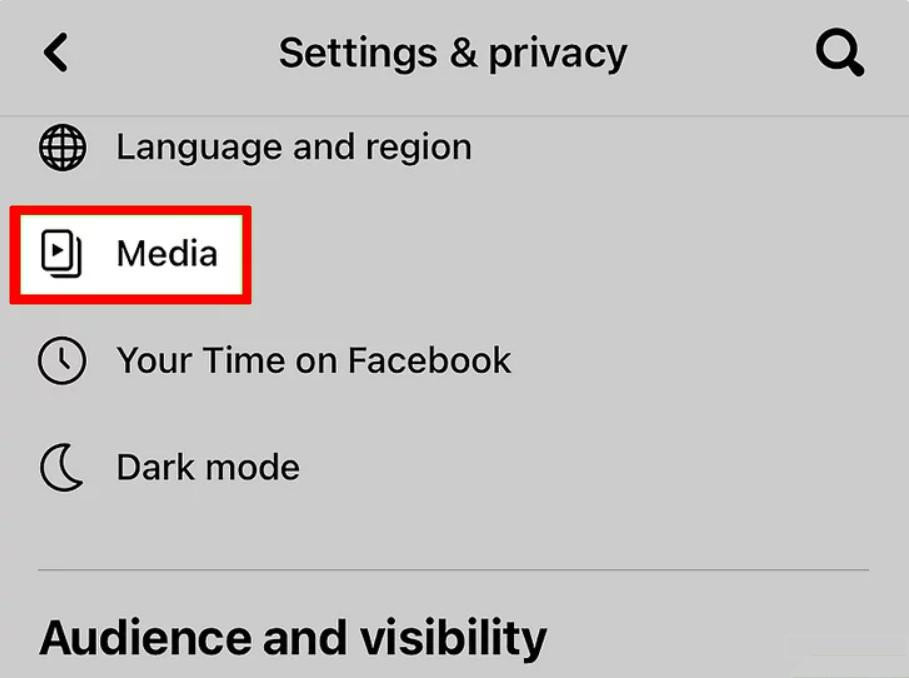 Steps to turn off in-app sounds on Facebook mobile
Steps to turn off in-app sounds on Facebook mobile
Now, you’ve muted those sound effects that occur when you tap, like, or comment on Facebook. But don’t stop there! There are more sounds to conquer.
Step 5: Staying within the “Sounds” section, navigate to “Video and Photo Settings” and switch off “Videos Start with Sound.” This ensures that videos won’t automatically play with sound as you scroll. If you want to hear a video, you can simply tap on it and then tap the speaker icon.
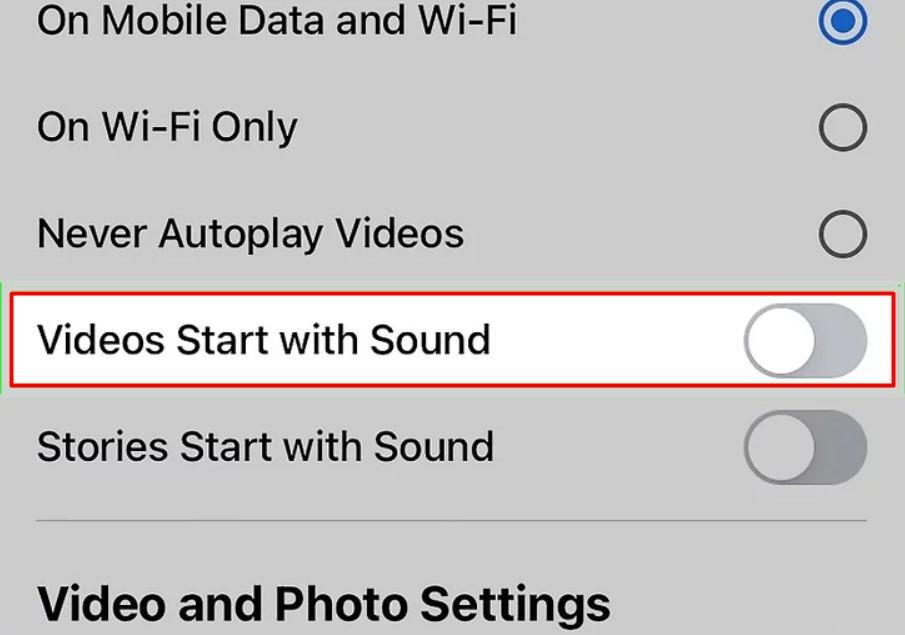 How to disable autoplay video sounds on Facebook
How to disable autoplay video sounds on Facebook
Step 6: On the same settings page, disable “Stories Start with Sound” to prevent stories from playing audio automatically. You can tap the speaker icon to enable the sound for individual stories as desired.
2. How to Disable Notification Sounds on Mobile Devices
Unwanted notification sounds on your mobile device can disrupt meetings, quiet time, and even your focus. Silencing them is easy.
Step 1: Follow the first four steps in section 1 until you’ve reached the “Settings & Privacy” menu. Instead of clicking on “Media,” tap on “Notifications.”
 Where to find notification settings on Facebook mobile
Where to find notification settings on Facebook mobile
Step 2: On the “Notifications” page, look for “Where You Receive Notifications” and select “Push.”
Step 3: To completely silence Facebook notifications, toggle off “Sounds” and “Vibrate” under “Push Notifications.” This will prevent any audible or tactile alerts from Facebook. Keep in mind that this won’t affect Messenger notifications unless you disable those separately.
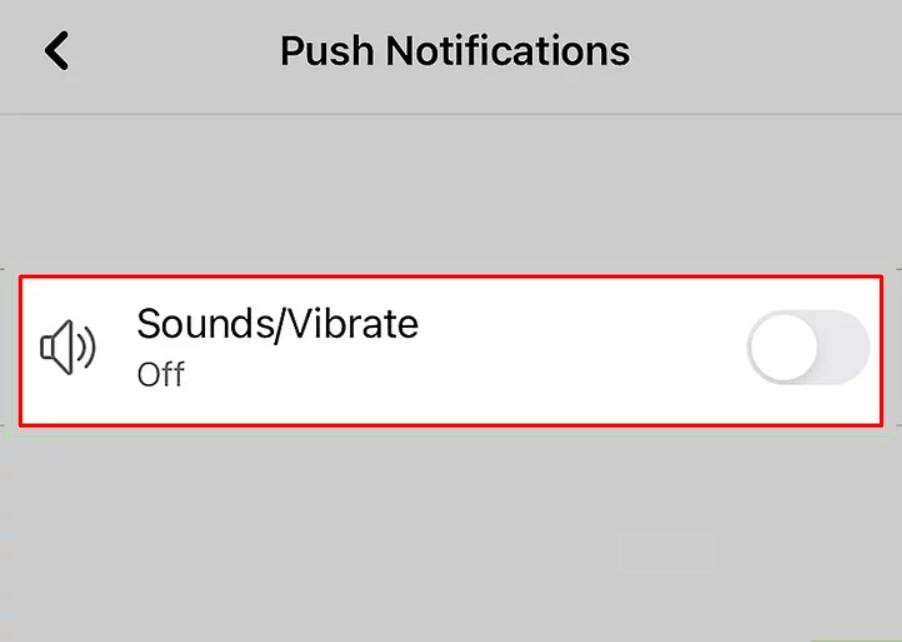 Steps to turn off push notification sounds on Facebook mobile
Steps to turn off push notification sounds on Facebook mobile
3. Turning Off Message and Call Sounds on a Computer
Are the message and call sounds on Facebook’s desktop version distracting? Here’s how to silence them:
Step 1: Open Facebook in your web browser and click on the “Message” icon, located in the top-right corner of the page.
Step 2: Click the three horizontal dots next to “Chats” to access the message settings.
Step 3: Toggle off “Message Sounds” and “Incoming Call Sounds.” Disabling “Incoming Call Sounds” prevents your computer from playing a ringtone when you receive a call on Facebook, while disabling “Message Sounds” mutes the sound that plays when you receive and send messages.
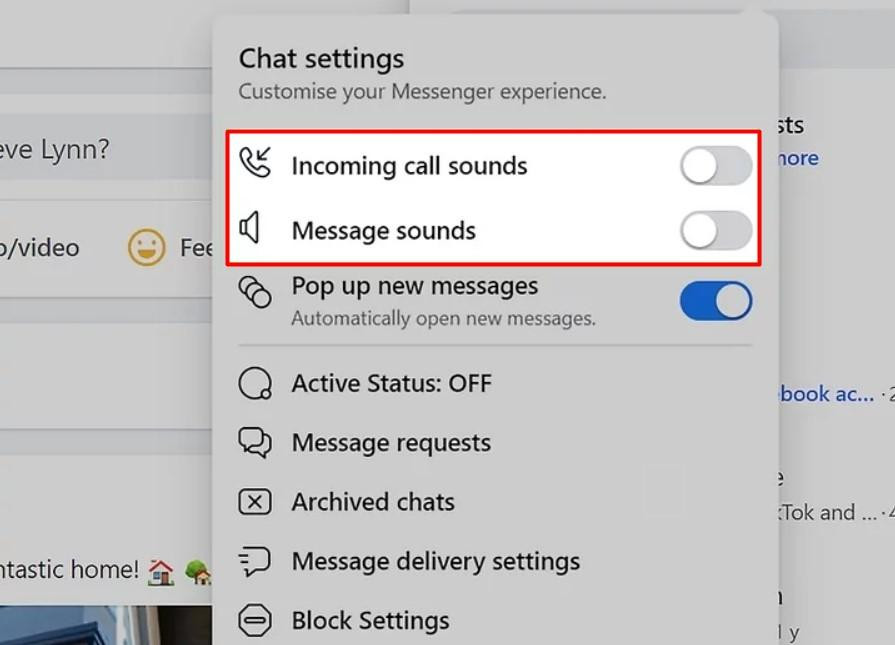 Disabling message and call sounds on Facebook desktop
Disabling message and call sounds on Facebook desktop
4. How to Turn Off Notification Sounds on a Computer
If you prefer using Facebook on your computer, you can also disable notification sounds there. Here’s how:
Step 1: Open Facebook on your computer and click the upside-down triangle menu icon in the top-right corner.
Step 2: Select “Settings & Privacy” and then “Settings.”
Step 3: Click on “Notifications” in the left-hand menu. Scroll down to locate the “Browser” section and click on it to expand the notification settings.
Step 4: Uncheck the boxes next to “Play a Sound when a message is received” and “Play a Sound when each new notification is received.” This will prevent Facebook from playing any notification sounds in your browser.
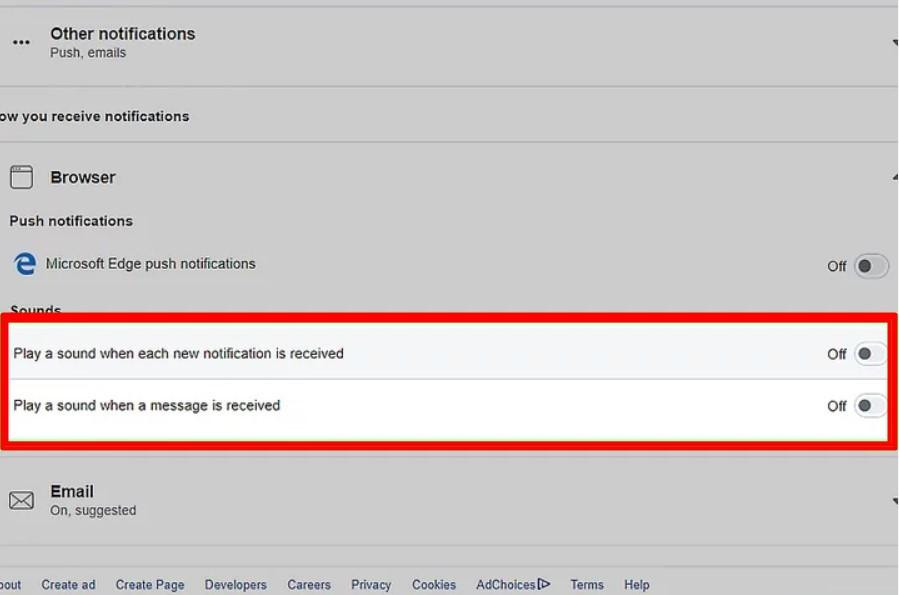 Turning off notification sounds on Facebook desktop
Turning off notification sounds on Facebook desktop
5. How to Turn Off Video Sounds on a Computer
If you don’t want videos on Facebook to start playing with sound automatically, you can disable this feature in your settings.
Step 1: Follow steps one and two in section 4 to access the “Settings & Privacy” menu.
Step 2: Scroll down the left-hand menu and select “Videos.”
Step 3: Change the “Auto-Play Videos” setting to “Off.” This will prevent videos from playing automatically on your computer, saving you from unexpected sounds.
6. Tailoring Your Facebook Experience
Taking control of Facebook’s sound settings can drastically improve your user experience. By following these steps, you can customize your sound preferences to suit your needs, whether you’re on a mobile device or a computer. Let’s delve into the various customization choices.
- Muting In-App Sounds: Disabling in-app sounds gives you control over those little noises that go with actions like liking or sharing.
- Notification Customization: You have control over sounds for new posts, friend requests, and messages.
- Video Autoplay Control: Stopping autoplay videos from making noise is great if you browse in public and don’t want to bother people.
- Sound Volume Adjustment: You can use device-level settings to make Facebook’s sounds quieter if you don’t want them off totally.
- Custom Notification Tones: You can set distinct notification sounds for Facebook so you know immediately when you have a notification.
7. Is Changing the Notification Sound for Facebook Possible?
If your issue isn’t about turning off click sounds on Facebook entirely but customizing the notification sound, here’s how to change it.
The Facebook Android version lets you choose a different sound for in-app notifications. Here are the steps for this:
Step 1: Open the Facebook app and select the hamburger icon.
Step 2: Click on “Settings & Privacy,” and then on “Settings.”
Step 3: Click on “Notifications” and then “Push.” Remember that “Push” is under “Where You Receive Notification.”
Step 4: Click on “Tone” and select the preferred sound.
That’s all! You’ve successfully changed the notification sound for Facebook. For every step highlighted in this post, you can revert it by going through the same process to toggle on the sounds.
8. Managing Your Digital Wellbeing
Being able to customize your Facebook sound settings is about more than just convenience. It’s a crucial element of digital wellbeing.
- Reduced Distractions: Switching off unnecessary sounds on Facebook helps people concentrate better, especially when they’re working, studying, or just unwinding.
- Respect for Others: In shared settings like libraries, classrooms, or public transportation, silencing your Facebook noises helps you be considerate of others.
- Increased Privacy: Turning off sounds can keep your online activities private, especially if you don’t want others to know when you’re getting notifications.
- Improved Sleep: Lowering the volume of notifications or turning them off can improve sleep quality if Facebook alerts keep you awake at night.
- Personalized Experience: You can make Facebook more user-friendly and less intrusive by tailoring the sound settings to fit your tastes and requirements.
9. The Impact of Urban Soundscapes on Digital Experiences
Urban soundscapes are the sounds that come from cities and can have an impact on our digital lives, even what we hear on Facebook. These sounds can give us ideas, make us feel things, and change how we use social media.
| Sound Type | Description | Impact on Facebook Usage |
|---|---|---|
| Traffic Noise | Sounds from cars, buses, and motorcycles. | Can be distracting; users might prefer muting videos or using headphones. |
| Construction Sounds | Sounds of drilling, hammering, and heavy machinery. | Might encourage users to reduce time on Facebook to avoid irritation. |
| Public Transportation | Sounds of trains, subways, and buses. | May lead users to browse Facebook with muted audio settings in transit. |
| Street Performers | Sounds of music, singing, and street performances. | Could inspire users to share live videos or posts about local artists. |
| Emergency Sirens | Sounds of ambulances, police cars, and fire trucks. | Can cause users to quickly check Facebook for local news and updates. |
| Human Voices | Sounds of conversations, shouting, and laughter. | May influence users to engage more in group discussions or comment on posts. |
| Nature Sounds | Sounds of birds, trees, and water features in urban parks. | Could encourage users to share photos or posts about their peaceful experiences in nature. |
| Industrial Sounds | Sounds from factories, warehouses, and industrial activities. | May prompt users to share concerns or discussions about environmental issues. |
| Events and Festivals | Sounds from concerts, parades, and public gatherings. | Can lead users to post photos, videos, and updates about their experiences at these events. |
| General City Ambiance | A mix of various background sounds that define the city’s atmosphere. | Shapes the overall context of social media interactions, affecting the mood and content shared by users. |
10. How to Make Facebook Less Annoying
If you frequently use Facebook, you’ll likely find the notification sounds annoying. Even if you’re not bothered about the sounds, the people around you can get irritated by them. This is especially true if it’s in a workplace environment. Whether you use the platform on mobile or computer, the notification sounds keep coming.
Thankfully, you can turn off the sounds on the web or mobile. Additionally, you can explore different ways to keep your Facebook private. You can hide Likes or mute annoying Facebook users on your contact.
11. The Role of Streetsounds.net in Enhancing Your Auditory Experience
Streetsounds.net can help you customize your Facebook sound experience by offering a variety of high-quality audio resources and insights.
- Sound Libraries: Streetsounds.net provides a vast library of urban soundscapes that can be used to create unique notification tones, giving your digital interactions a distinctive and personalized auditory signature.
- Expert Insights: Articles and tutorials provide detailed guidance on managing audio settings on various social media platforms, including Facebook, ensuring users can customize their sound experience.
- Community Engagement: Streetsounds.net fosters a community of sound enthusiasts, allowing users to share tips, tricks, and creative ideas for personalizing their digital sound environment.
- Sound Design Tools: Access to sound design tools and resources enables users to create custom soundscapes, making their Facebook interactions more immersive and engaging.
- Educational Resources: The website offers educational materials on the impact of sound on perception and emotion, helping users make informed decisions about their auditory environment.
12. Exploring Streetsounds.net: Your Gateway to Urban Audio Adventures
Ready to dive deeper into the world of urban sound? Streetsounds.net invites you to explore our extensive library of sound effects, articles, and community forums.
- Sound Library: Immerse yourself in thousands of high-quality recordings capturing the essence of urban life. Whether you’re seeking the cacophony of Times Square or the subtle hum of a Brooklyn alleyway, our library has it all.
Address: 726 Broadway, New York, NY 10003, United States.
Phone: +1 (212) 998-8550. - Articles: Learn about the history, culture, and technical aspects of urban soundscapes through our in-depth articles. Discover how street sounds influence music, film, and art, and gain insights into the art of field recording and sound design.
- Community: Connect with fellow sound enthusiasts, artists, and professionals in our vibrant community forum. Share your experiences, collaborate on projects, and get inspired by the creativity of others.
- Join Us Today: Visit streetsounds.net to start your urban audio adventure. Whether you’re a seasoned sound designer or a curious explorer, we have something for everyone.
13. Real-World Examples of Sound Customization
Let’s examine a few actual instances of how people have tailored their Facebook sound settings to suit their needs and tastes.
- The Remote Worker: A remote worker mutes all Facebook sounds during work hours to avoid distractions. She sets a unique, peaceful tone for after-work notifications to disconnect and unwind.
- The Student: While studying, a student silences all Facebook sounds but sets a subtle vibrate alert for messages from close friends. This keeps them focused without totally disconnecting.
- The Parent: A parent sets unique notification tones for Facebook messages from family members so they know when to check quickly. They mute all other Facebook noises to avoid bothering others.
- The Artist: An artist uses urban soundscapes from Streetsounds.net to make unique notification sounds for their Facebook profile, adding a personal touch to their online interactions.
- The Traveler: A traveler silences all Facebook sounds while visiting a foreign city to fully immerse themselves in the local sounds and experiences. They check alerts later, when convenient.
14. Staying Up-to-Date with Sound Trends
Staying up to date on sound trends is essential to maximizing your audio experience on Facebook. Here are some of the latest trends and developments in the world of sound.
| Trend | Description | Impact on Facebook Users |
|---|---|---|
| ASMR | Autonomous Sensory Meridian Response; sounds that create a tingling sensation. | More users may seek ASMR-related content on Facebook, leading to increased engagement with ASMR videos and groups. |
| Binaural Audio | 3D audio that creates an immersive listening experience. | Users might prefer binaural audio content for a more realistic and engaging experience, especially with headphones. |
| Sound Personalization | Tailoring audio settings to individual preferences. | Users will increasingly customize notification tones and audio settings to fit their personal needs and preferences. |
| AI-Generated Sounds | Sounds created using artificial intelligence. | More AI-generated sounds may appear in videos and content, potentially offering unique and creative audio experiences. |
| Noise Cancellation | Technologies that reduce or eliminate unwanted background noise. | Users may use noise-canceling headphones to improve focus while browsing Facebook in noisy environments. |
| Spatial Audio | Audio that creates a sense of space and direction. | Spatial audio may enhance the immersive quality of videos and live streams, providing a more realistic sound experience. |
| Sound Branding | Using unique audio cues to identify a brand or product. | Companies may incorporate sound branding in their Facebook ads and videos to create a memorable and recognizable brand identity. |
| Mindfulness Sounds | Sounds designed to promote relaxation and reduce stress. | Users might seek mindfulness-related audio content on Facebook to help manage stress and improve mental wellbeing. |
| High-Resolution Audio | Audio with higher fidelity and detail than standard audio formats. | Users may demand higher-quality audio for music and videos, leading to the adoption of high-resolution audio formats on Facebook. |
| Interactive Audio | Audio that responds to user input or actions. | Interactive audio may enhance the engagement of games and interactive content, providing a more dynamic user experience. |
15. The Science Behind Sound Perception
Understanding how we perceive sound can give you more control over your Facebook audio experience. Our brains decode sounds according to frequency, amplitude, and timbre, all of which have an impact on how we feel and react.
- Frequency: The sound’s pitch is measured in hertz (Hz). High-frequency sounds may be more irritating, whereas low-frequency sounds can be more calming.
- Amplitude: The volume or loudness of a sound is measured in decibels (dB). High-amplitude sounds can be upsetting, whilst low-amplitude sounds are more subtle.
- Timbre: The tone’s quality or color. Different timbres can elicit different feelings, with some being more pleasant than others.
16. A Call to Action: Join the Streetsounds.net Community
Are you ready to take your audio experience to the next level? Visit streetsounds.net to explore our vast sound library, read insightful articles, and connect with a community of sound enthusiasts.
Address: 726 Broadway, New York, NY 10003, United States.
Phone: +1 (212) 998-8550.
- Explore Our Sound Library: Discover thousands of high-quality recordings that capture the essence of urban life.
- Read Insightful Articles: Learn about the history, culture, and technical aspects of urban soundscapes.
- Connect with Our Community: Share your experiences, collaborate on projects, and get inspired by the creativity of others.
Join streetsounds.net today and start your urban audio adventure. Whether you’re a seasoned sound designer or a curious explorer, we have something for everyone.
17. FAQs on How to Turn off Click Sounds on Facebook
#1: How do I disable “Like” sounds on Facebook?
When you turn off in-app sounds with the steps highlighted above for mobile, it automatically turns off other sound effects, including Like sounds.
#2: Why do Facebook sounds keep turning on?
To permanently stop Facebook sounds from playing, you have to manually disable all sounds. Go to the Facebook app’s settings to turn off “Videos in News Feed Start with Sound.” This should stop the sound from automatically playing.
#3: Why do my Facebook notifications sound this loud?
Facebook updates may cause glitches in Facebook and Messenger apps. This can make notifications and sounds louder than they usually are. You can try to reduce the device’s volume manually to adjust the loudness. If this doesn’t work, check to see if there’s a new version available and update the app.
#4: How do I control video autoplay on Facebook?
Disabling video autoplay can be done in the settings menu under “Videos.” You can choose to never autoplay videos or only autoplay on Wi-Fi.
#5: Can I set custom notification sounds for specific Facebook contacts?
Unfortunately, Facebook does not offer a feature to set custom notification sounds for individual contacts. Notification sounds are generally set for the entire app.
#6: Will turning off sounds affect my Facebook Messenger notifications?
Turning off sound notifications within the Facebook app does not automatically disable notifications for Facebook Messenger. You will need to adjust the settings in the Messenger app separately.
#7: How do I manage sound settings for Facebook Live videos?
During a Facebook Live broadcast, you can mute your microphone to prevent any sound from being transmitted. Viewers can also adjust the volume of the live stream on their devices.
#8: Are there any third-party apps to enhance Facebook sound customization?
There are third-party apps available that claim to enhance sound customization for various apps. However, it’s important to exercise caution when using such apps, as they may pose security risks.
#9: How does my device’s “Do Not Disturb” mode interact with Facebook sounds?
When your device is in “Do Not Disturb” mode, it silences all notifications, including those from Facebook. However, you can customize the settings to allow notifications from specific contacts or apps.
#10: Can I adjust sound settings for Facebook on different devices independently?
Yes, sound settings for Facebook can be adjusted independently on different devices. Changes made on one device will not automatically sync to other devices.
